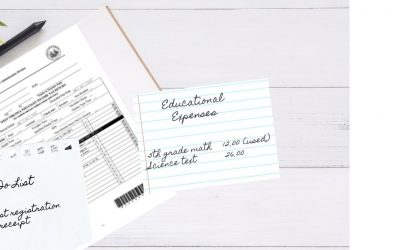Aha! Testing time! Moms may worry about how their littles are going to do and so may head over to Barnes and Noble for the Test Prep workbook, but there are actually many (and perhaps even better) ways to prepare.
In the earliest grades, many of the questions are read aloud and the choices are shown in picture form. Exposure to many different environments and situations can actually help these students figure out what the picture choices represent. Besides, these are good foundational learning experiences.
For example, going to the library together and picking out books about animals, their habitats, and their young for read-aloud and discussion is a great way to learn and prepare. Measuring things (the length of a toy, the weight of the dog, the height of the doorway) and discussing how to do it and perhaps making a nice list of comparison sizes (dog versus elephant) can help. Which is longer? Heavier? Observe things in everyday life – how ice cubes are bigger than the water before it is frozen, or how it’s more difficult to walk uphill the steeper it is.
Just gradually teaching your child to attend to his or her daily work is also a big help. Can they sit and follow directions for a couple hours? Usually that means that you’ve taken a few weeks to gradually increase the amount of time that they can sit and work. Start with ten minutes of read-aloud time with a couple questions afterward. Slowly increase that time, watching for their ability to attend. When their mind wanders, stop for the day. Then see if they can work for one or two additional minutes tomorrow.
In these years, children are not well designed to sit for extended periods of time and usually do not yet have the ability to stay focused on book work for all that time. Even if they’ve been taught to sit politely and not cause trouble, that still doesn’t mean that they can keep their minds focused after two hours of testing. If you know your child is not developmentally ready to do that, perhaps you should consider private testing so you can lengthen administration over more days. Or, switch to a portfolio review until about 3rd grade. At the very least, you should hold the test scores lightly. And remember, a child who is unable to attend for that long at these ages is not a “bad” child nor necessarily a “slow”child. Perhaps he is just not developmentally ready for this type of testing environment. The experience may help him become more familiar with testing, but the scores may not accurately reflect his knowledge.
To hold the test scores lightly, you and your spouse must put the scores in perspective. For instance, if the math score is lower than you would expect, you know that this may or may not actually reflect the math that your child knows. Therefore, it doesn’t necessarily reflect what you will see in later testing. Encourage your child to do his best, but don’t put undo pressure or value on testing, especially in these years.
What should you tell your child about testing? We think it’s important to be firm about behavior expectations, but light about results. In other words, it may not be wise to talk about how they should do their best so that they won’t fail. It can be very counter-productive to say things such as if they don’t do well they might have to repeat a grade, or worse, flunk, or especially that they need to do well so that the county thinks they are doing okay. All of those types of statements put too much pressure on a young child – placing the responsibility for the success of his schooling on his testing performance. No wonder such a child might be nervous before testing, learn to dread it, and not then feel well enough to really do his best. Instead, put the emphasis on sitting quietly, listening carefully, and doing his best. “Sweetheart, you will have to work hard today to listen carefully to what the teacher says and do your best to follow the instructions.” Remind him that there will be questions that he does not know the answer to, and that it’s okay. A second-grader might be able to understand how to eliminate some answers and then guess between the ones left. But don’t stress if your child does not yet understand that concept.
If testing time is not dreaded by your child, he or she will tend to do better. For our family, we calmly talked about how it would be nice to see our friends and we did not do additional school when we got home. Between those two things, it was a welcome break for everyone! In fact, we purposely did fun things in the afternoons after testing!
Think of these years as setting a solid foundation for later testing. If your child learns to like testing and to be comfortable in testing situations, that will go a long way in helping him later on.
Below are a few developmental milestones and the usual ages that children attain them. Notice that several of these could affect test performance. Note, too, that although children usually progress through the same order of milestones, each child grows and gains skills at his own pace. Therefore, milestone ages (such as the ones given below) are just averages. At this age, being behind or ahead of these averages does not usually indicate anything about intelligence because normal rates of development vary so greatly.
- Uses future tense: 5 years old
- Speaks sentences with more than five words – 5 years old
- Better understands the concept of time – 5 years old
- Can ignore minor distractions and if alone, will focus on an interesting activity for 10-15 minutes or an assigned task for 4-6 minutes – 5 years old
- Personal interest is the most important motivation for a 5-year-old. It will double their attention span.
- A normal attention span is sometimes said to be 3-5 minutes per year of age.
- Directions should be given in chronological order. They can’t turn them around at age 5-6.
- Pictorial directions are better understood than verbal directions at age 5-6.
- By age 6 most children understand the concept of “10.” For example, they can count 10 objects (which is harder than rote, verbal counting to 10 or beyond).
- By around age 6, children are beginning to understand cause and effect relationships.
- By around age 6 they can read simple words and can describe a story.
- Can follow 2- to 3-part commands by around age 5. For instance, “Put your book down, brush your teeth and get in bed.”
For more information about learning during the preschool years through about age 5, see our preschool section under “Helps.”
For parents who want to use test prep materials, workbooks can be purchased at many bookstores such as Barnes & Noble or Books-A-Million. Or they can be purchased from our test distributor, BJU Press Testing, here. Materials are also available from Amazon via our Amazon Smile (see right sidebar). Once at Amazon, search for “standardized test practice.”





Recent Comments